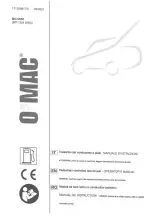
15
TRANSPORTING
If the engine has been running, allow it to cool before loading the
mower on the transport vehicle. A hot engine and exhaust system can
burn you and can ignite some materials.
Turn the fuel valve to the OFF position. This will prevent carburetor
flooding and reduce the possibility of fuel leakage.
If installed, remove the grass bag.
If a suitable loading ramp is not available, two people should lift the
mower on and off the transport vehicle while holding the mower level.
Position the mower so all four wheels are on the bed of the transport
vehicle. Tie the mower down with rope or straps, and block the
wheels. Keep the tie-down rope or straps away from the controls,
adjustment levers, cables, and the carburetor.
Fold the handlebar so the mower will take up less space (
STORAGE
Proper storage preparation is essential for keeping your lawn mower
trouble free and looking good. To help keep rust and corrosion from
impairing your lawn mower’s function and appearance, and to make
the engine easier to start after storage, follow the instructions
described in this section to:
• Drain or treat the fuel
• Change the oil and coat the engine cylinder
• Clean the mower, engine, and grass bag
• Choose a storage location
Fuel
See “AVOIDING FUEL-RELATED PROBLEMS” on
for a list of
recommended procedures to avoid fuel related problems.
The
DISTRIBUTOR’S LIMITED WARRANTY
(
) does not
cover fuel system damage or engine performance problems resulting
from neglected storage preparation.
Oil
Change the engine oil (see
Add oil in the engine cylinder to prevent rust.
1. Remove the spark plug (
2. Pour a teaspoon (5 cc) of clean
engine oil into the cylinder to
keep it from rusting.
3. Pull the starter rope several times
to distribute the oil in the cylinder.
4. Reinstall the spark plug.
5. Pull the starter rope slowly until
resistance is felt, and then return
the starter grip gently. This will
close the valves so moisture
cannot enter the engine cylinder.
Cleaning
Mower Deck
Allow the engine to cool before cleaning or washing.
Before cleaning or washing the underside of the mower deck, stop the
engine and turn the fuel valve to the OFF position. Rest the mower on
its right side, so the fuel cap side is up. This will help to prevent fuel
leakage and hard starting due to carburetor flooding. Wear heavy
gloves to protect your hands from the blades.
Remove any grass clippings from the underside of the mower deck,
paying attention to the areas surrounding the Clip Director shutter
lever and housing.
Be careful to avoid getting water into controls and cables, or
anywhere near the engine air cleaner or muffler opening.
Engine
Allow the engine to cool before washing.
Wash the engine by hand, and be careful to prevent water from
entering the air cleaner and exhaust opening.
NOTICE
Using a garden hose or pressure washing equipment can force water
into the air cleaner. Water in the air cleaner will soak the paper filter
and can enter the carburetor or engine cylinder, causing damage.
Water contacting a hot engine can cause damage. If the engine has
been running, allow it to cool before washing.
Grass Bag
Remove the bag from the mower, and wash it with a garden hose or
pressure washer. Allow the bag to dry completely before storage.
Drying
After washing the lawn mower, wipe dry all accessible surfaces.
Place the mower with its wheels on a level surface. Start the engine
outdoors and let it run until it reaches normal operating temperature to
evaporate any water remaining on the engine.
Stop the engine and allow it to cool.
After the lawn mower is clean and dry, touch up any damaged paint,
and coat other areas that may rust with a light film of oil.
Storage Location
If your mower will be stored with gasoline in the fuel tank and
carburetor, it is important to reduce the hazard of gasoline vapor
ignition. Select a well-ventilated dry storage area away from any
appliance that operates with a flame, such as a furnace, water heater,
or clothes dryer. Also avoid any area with a spark-producing electric
motor, or where power tools are operated.
Make sure the fuel valve is in the OFF position to reduce the
possibility of fuel leakage.
Place the mower with its wheels on a level surface. Tilting can cause
fuel or oil leakage.
With the engine and exhaust system cool, cover the mower to keep
out dust. A hot engine and exhaust system can ignite or melt some
materials. Do not use sheet plastic as a dust cover. A nonporous
cover will trap moisture around the mower, promoting rust and
corrosion.
SPARK
PLUG
HOLE
OIL










































